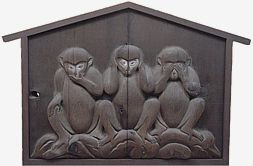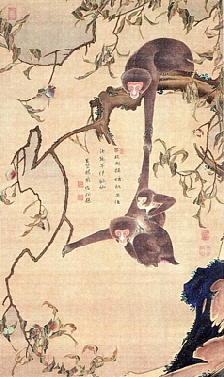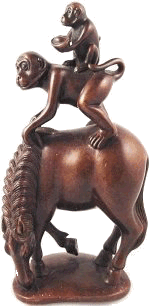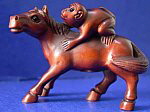|
2016
YEAR OF THE MONKEY
1932, 1944, 1956, 1968, 1980, 1992, 2004, 2016
Patron Buddhist Deity = Dainichi Buddha
May Favorable Winds
Fill Your Sails
|
Merry Christmas & Happy New Year 2016

|
|
|
|

Speak No Evil, Hear No Evil, See No Evil
This imagery probably originated in Japan.
Wood Carving, ca. 1646
Hase Dera, Kamakura, Japan
|
THE MONKEY 猿 (Jp. = saru)
One of the twelve creatures of the Asian Zodiac cycle, the monkey is a common motif in Hindu lore (India) and Zodiac/Taoist/Buddhist lore (China/Japan). In all traditions, the monkey is portrayed as foolish, vain, and mischievous. Yet, in each tradition, the monkey learns valuable lessons along the way, makes changes, and eventually gains redemption. The monkey thus embodies the themes of repentance, responsibility, devotion, and the promise of salvation to all who sincerely seek it. This symbolism is still common in Buddhism as practiced today. In modern meditation practices, one must first subdue the "monkey mind" before meditation can yield results. The goal is to overcome the restless monkey mindset, to stop jumping from branch to branch, to stop grabbing whatever fruit comes into sight, to stop being fooled by mere appearances. Salvation is within the grasp of all who seek it if they remain true, sincere, and dedicated.
|
|
|
 |
|
 |
|
Monkey Lore in China and Japan
|
|

|
CATCHING THE MOON'S REFLECTION
A Chinese story, known in Japan as Enkō Sokugetsu 猿猴捉月.
< Story as quoted by JAANUS >: One night a monkey chieftain saw the bright reflection of the moon in the water below his tree. Thinking that the moon had died and fallen into the water, and fearing that the world would thus slip into darkness, the monkey called together his underlings and commanded them to join tails and together pull the moon out of the water. However, when the monkeys attempted this task, their combined weight was too great, the branch broke, and they fell into the water and drowned.
One simple moral of the story is not to recklessly attempt impossible tasks. On a more philosophical level, the image of the monkey attempting to grasp a reflection of the moon is a metaphor for the unenlightened mind deluded by mere appearances. The theme was often depicted in Japanese ink paintings, usually featuring long-armed spider monkeys. The screen paintings by Shikibu 式部 (16c; Kyoto National Museum) and Hasegawa Tōhaku 長谷川等伯 (1539-1610; screen painting at Konchiin, Kyoto), are representative. <end JAANUS quote>
PAINTING
by Itō Jyakuchū 伊藤若冲 (1716-1800), private collection
|
|
|
|
|
Monkeys as Protectors Against Evil & Illness. Monkeys as Patrons of Marriage & Fertility.
The color red is closely linked to warding off illness and evil, and to fertility and children.
|
|
|
|
|
|
|
|
Migawari-zaru 身代わり猿, literally "substitution monkey," are red lucky charms that drive away evil and vicariously receive our suffering and bad luck. In some parts of Japan, one charm for each person of the home is hung on the eves of the house, especially on Days of the Monkey (Kōshin 庚申の日), when evil spirits are afoot and try to enter the bodies of sleeping humans. Staying up all night (Kōshin Machi 庚申會) and buying a charm helps stave off the evil invaders. The Kōshin Machi is still observed today.
|
Munamochi Saru 棟持猿, literally "pillar-supporting monkey." Some of Japan's Hiei shrines 日吉神社 use monkey carvings to hold up the roof beams. These pillar monkeys reflect the simian's traditional role in Japan as protector against evil. The monkey's role in guarding against demons originates in part from word play, for the word for monkey (猿 = saru) is a homonym for the word "expel" (去る = saru). The latter means to "dispel, punch out, beat away."
|
Gate Guardians. A female monkey holding babe and a male monkey sometimes guard the entrance gate to Japan's many Hiei shrines. These guardians are often decked in red -- a color closely linked to fertility, children, and warding off illness, like smallpox. They are also dedicated to Sannō 山王 (mountain king), who is the central deity of the Shintō-Buddhist multiplex on Mt. Hiei (near Kyoto). The monkey is Sannō's messenger (tsukai 使い).
|
Sarumata 猿股, literally "monkey underwear." It equates to the red buttocks of female monkeys in heat, and thus symbolizes fertility. Monkeys are worshipped at many Hiei shrines in modern Japan. They are considered patrons of marriage, fertility, and safe childbirth. At these shrines, monkey icons are often decked in red clothing, the color meant to symbolize fertility and children, and the warding off of illness and evil. There are some 3,800 Hiei shrines nationwide.
|
Yasaka Kōshindō Temple 八坂庚申堂 in Kyoto sells clay monkey figurines which resemble fingers. The temple says they are lucky charms for musicians, calligraphers, and others whose livelihood depends on their fingers. Monkey charms (migawari-zaru 身代わり猿) are hung on long strings throughout the compound. They are meant to ward off evil, especially on Days of the Monkey 庚申の日, when evil abounds. Three monkeys are perched atop the outside gate and inner altar.
|
|
 |
|
|
|
Japan: Three Monkeys, Kōshin Vigil, and Shōmen Kongō
|
|
In Japan, certain Zodiac days/years of great misfortune are known as Kōshin 庚申 (Chn = gēngshēn). On these days/years, special rites -- influenced greatly by Chinese Taoist rites involving three worms and nine parasites that inhabit the body, but now an entirely Buddhist ritual in Japan -- are performed to ward off evil influences, to protect against sickness and misfortune, and to cure illness. A major player in Kōshin rituals is the monkey, for the term Kōshin 庚申 is comprised of two characters -- Kō 庚, the Chinese Zodiac stem associated with metal, and Shin 申, the ninth branch symbol of the Zodiac, which is also the character for monkey. Another key player in Kōshin rituals is Shōmen Kongō 青面金剛, a multi-armed esoteric deity often depicted in artwork standing atop three monkeys.
In Taoist traditions from China, first documented in the 4th century AD, on the night before a Kōshin Day, THREE WORMS (三蟲; also called three corpses / deathbringers 三尸) believed to dwell in the human body escape from the body and visit the Court of Destiny 司命 (ruled by the Emperor of Heaven 天帝) to report on the sleeping person's sins. Depending on this report, the Court of Destiny might decide to shorten the individual's life. To prevent this, people stay awake on Kōshin nights (the eve of the Kōshin day), gathered around scrolls of Shōmen Kongō. This practice eventually became known, in Japan, as the Kōshin Machi 庚申會 (Kōshin Vigil, Kōshin Wake, Kōshin Gathering).
Although the exact origin of the Kōshin ritual in Japan is uncertain, it is quite probable that Kōshin practices were first brought to Japan by early Tendai monks who had visited China (e.g., Saichō, 最澄, 766-822 AD; Ennin 円仁 794-864 AD; and Enchin 円珍 814-891 AD) and returned home with Chinese medical texts that contained details on this Taoist practice. Many of these Chinese documents are cited in subsequent court/temple records, yet none of these early documents mention the three monkeys. I therefore posit that the three monkeys are a Japanese innovation, equivalent to the three Chinese worms.
Today, Shitennō-ji Temple in Osaka is the largest, oldest, and most revered site for Kōshin rituals in Japan, and its Kōshin Hall still performs the Kōshin rites six times each year. During the Kōshin rituals at this temple, believers are gathered before scrolls of Shōmen Kongō and pummeled, from head to legs, with a wooden monkey figurine, which apparently ensures future health. The basic rules for Kōshin participants are: do not speak evil, do not use bad language, do not get angry, do not get caught up in passion, do not think evil thoughts, do not think of sex, do not eat the flesh of animals that have four feet or two feet, and do not touch the five strong-smelling vegetables. Says scholar Livia Kohn: "Modern-day Kōshin rituals are inalienably Buddhist, having long ago lost their Taoist origins." Photo from Shitennō-ji Temple poster.
|
|
|
|
 |
|
Monkey as Protector of Horses, Protector of Stables
|
|
 
|
In Chinese and Japanese artwork, the monkey is often shown riding the horse. This symbolism stems from the classic 16th-century Chinese story Journey to the West, in which the Jade Emperor appoints the monkey to the post of "Protector of Horses" to pacify the monkey's desire for power and recognition. The monkey soon discovers that his posting as Stable Protector is empty (without real power or merit), and again returns to his mischievous ways, stealing the peaches of immortality and causing trouble for all until he is defeated by the Buddha.
In a similar vein, Chinese artwork depicting a monkey atop a horse was also based on word play. The Chinese good-luck expression Ma Shang Feng Ho 馬上蜂猴, literally "horse above bee monkey," was a phrase often used as a closing in letter writing, conveying the idea "may you be immediately awarded noble rank." MA SHANG means "immediately," but its literal translation is "atop a horse." FENG, meaning "bee," is a homonym of another word meaning "awarded." HO, meaning "monkey," is a homonym of another word meaning "nobleman." Thus FENG HO can mean either "bees and monkeys" or "be awarded noble rank."
|
|
|
 |
|
|
|
|